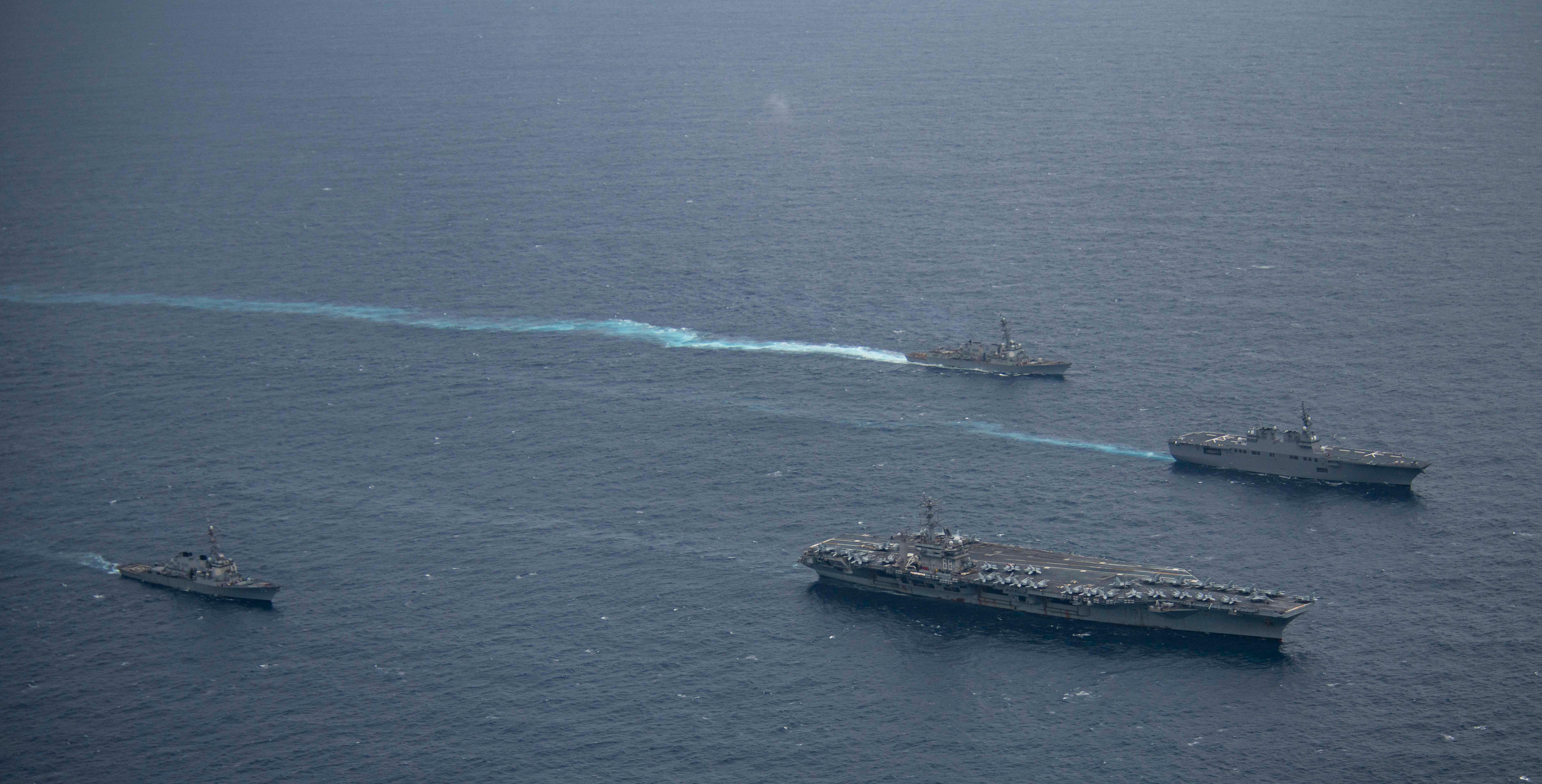
The Nimitz Carrier Strike Group docked at the port of Busan, South Korea on Tuesday to mark the 70th Anniversary of the U.S-South Korea alliance ahead of more trilateral drills with the Republic of Korea Navy and the Japan Maritime Self-Defense Force.
The Nimitz CSG currently includes carrier USS Nimitz (CVN-68) with embarked Carrier Air Wing (CVW) 17, cruiser USS Bunker Hill (CG-52) and destroyers USS Wayne E. Meyer (DDG-108) and USS Decatur (DDG-73). USS Paul Hamilton (DDG-60) and USS Chung-Hoon (DDG-93) are currently detached, with Paul Hamilton operating under U.S. 5th Fleet in the Arabian Sea, while Chung-Hoon is operating in the South China Sea.
The CSG is expected to depart Busan next week following an open house for Korean citizens on Saturday as part of the anniversary celebrations.
Last week, the Makin Island Amphibious Ready Group comprising of amphibious assault ship USS Makin Island (LHD-8), amphibious transport docks USS John P. Murtha (LPD-26) and USS Anchorage (LPD-23) and the embarked 13th Marine Expeditionary Unit docked at Busan as part of its participation in Exercise Ssangyong. The ARG departed on Sunday and is now operating in the waters near Pohang,
Before arriving at Busan, the Nimitz CSG drilled with the JMSDF and ROKN. Nimitz, Wayne E. Meyer and Decatur exercised with JMSDF helicopter destroyer JS Ise (DDH-182) from Thursday to Sunday in the Philippine Sea, according to a Monday news relase from the U.S. Navy.
On Monday, Nimitz, Bunker Hill, Wayne E. Meyer and Decatur conducted drills with ROKN destroyers ROKS Sejong the Great (DDG-991) and ROKS Choe Young (DDG-981), and replenishment ship ROKS Hwacheon (AOE-59) in the waters south of Jeju Island as part of the U.S. – ROK Warrior Shield field training exercises.
The exercises between the U.S., South Korea and Japan come as North Korea continued its campaign of launching ballistic missiles. Japan’s Ministry of Defense reported that two ballistic missiles were launched from the west coast of North Korea on Monday, with both missiles landing in waters off the east coast of North Korea. The first missile launched at around 7:47 a.m. local time and flew about 220 miles at a maximum altitude of about 31 miles. The second missile launched at around 7:57 a.m. and flew about 220 miles at a maximum altitude of about 31 miles.
On Tuesday, two Russian Navy Tarantul class corvettes launched Moskit P-270 Moskit missiles at a mock sea target in the Sea of Japan. Videos released of the firings showed RFS R-261 (991) as one of the two corvettes and missile range instrumentation ship RFS Marshal Krylov also taking part in the firing exercise. The Russian Defense Ministry said the two missiles successfully hit the target located about 60 miles.
Meanwhile, Russian and Chinese intelligence ships have been transiting Japan’s Tsushima Strait, based on releases by the Joint Staff Office (JSO) of Japan’s Ministry of Defense. Russian Navy intelligence ship Kareliya (535) was sighted at 7 a.m. local time on Saturday sailing northeast in an area 87 miles west of the Goto Islands. From Saturday to Sunday, it transited the Tsushima Strait to enter the Sea of Japan, according to a Monday JSO release.
Officials said multi-purpose support ship JS Amakusa (AMS-4303) and JMSDF P-1 Maritime Patrol Aircraft (MPA) of Fleet Air Wing 1 stationed at JMSDF Kanoya Air Base, Kyushu, and Fleet Air Wing 4 based at Naval Air Facility Atsugi, Honshu, shadowed the Russian ship.
The JSO spotted People’s Liberation Army Navy (PLAN) intelligence ship Kaiyangxing (796) on Monday sailing northeast in an area 100 miles west of the Goto Islands and. On Tuesday the ship transited the Tsushima Strait to enter the Sea of Japan, according to a Tuesday release. Fast attack craft JS Shirataka (PG-829) and JMSDF P-1 MPAs of Fleet Air Wing 4 monitored the Chinese ship, according to the release.
On Sunday, Royal Canadian Navy (RCN) frigate HMCS Montreal (FFH336) and replenishment ship MV Asterix departed Halifax, Canada, for a six-month deployment to the Indo-Pacific.
A Canadian Department of National Defense release stated that this is the first time an East Coast-based RCN frigate deployed to the Indo-Pacific.
Montreal will also participate in Operation Neon, Canada’s contribution to multinational efforts to monitor sanctions imposed on North Korea by the United Nations Security Council, according to the release. The two ships will sail through the Mediterranean and exercise with NATO ships operating there while on their way to the Indo-Pacific.





